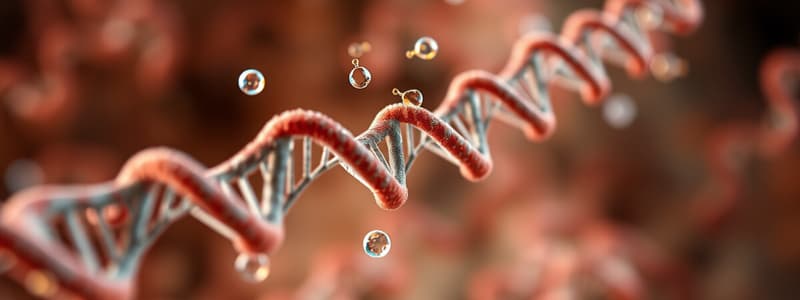Podcast
Questions and Answers
Which of the following are types of nitrogenous bases?
Which of the following are types of nitrogenous bases?
- Cytosine (correct)
- Glycine
- Adenine (correct)
- Thymine (correct)
What are the two types of nucleic acids?
What are the two types of nucleic acids?
DNA and RNA
What do nucleotides consist of?
What do nucleotides consist of?
A nitrogenous base, a sugar, and a phosphate group
Nucleosides consist of a nitrogenous base and a phosphate group.
Nucleosides consist of a nitrogenous base and a phosphate group.
What is the central dogma of molecular biology?
What is the central dogma of molecular biology?
Which of the following statements about DNA is true?
Which of the following statements about DNA is true?
Uracil is found in RNA but not in DNA.
Uracil is found in RNA but not in DNA.
What is the role of nucleic acids in cells?
What is the role of nucleic acids in cells?
The scientific concept that describes the process where DNA is copied to RNA is known as ______.
The scientific concept that describes the process where DNA is copied to RNA is known as ______.
Flashcards are hidden until you start studying
Study Notes
Nucleotides and Nucleic Acids
- Nucleotides are the building blocks (monomers) of nucleic acids, consisting of a nitrogenous base, a sugar, and a phosphate group.
- Nucleic acids are large biomolecules (DNA and RNA) that store and transmit genetic information essential for cellular functions, particularly in protein synthesis.
Nitrogenous Bases
- Guanine: A purine base characterized by an NH2 substituent at carbon 2 and a carbonyl group (C=O) at carbon 6.
- Cytosine: A pyrimidine base with an NH2 group at carbon 4 and a carbonyl group at carbon 2.
- Thymine: Another pyrimidine base containing a carbonyl group at carbon 2 and carbon 4, and a methyl group (CH3) at carbon 5.
- Uracil: A ribonucleotide base that replaces thymine in RNA sequences.
Structure of Nucleic Acids
- DNA houses genetic information in the nucleus while RNA plays various roles in translating that information into proteins.
- Eukaryotic DNA is double-stranded and highly negatively charged, which contributes to its stability and integrity.
- Central Dogma of Molecular Biology highlights the flow of genetic information from DNA to RNA to protein synthesis.
Key Types of RNA
- Various types of RNA molecules include mRNA (messenger RNA), tRNA (transfer RNA), and rRNA (ribosomal RNA), each with distinct functions in the process of gene expression and protein synthesis.
DNA Properties
- DNA's chemical structure facilitates accurate duplication and transcription, guaranteeing fidelity during processes of cell division and gene expression.
- DNA denaturation and renaturation are crucial for processes such as replication and transcription.
Learning Objectives
- Differentiate between nucleic acids, nucleosides, and nucleotides.
- Describe the structural characteristics of DNA and RNA.
- Understand the directional nature of nucleic acid sequences.
- Explain the significance of negative charge in eukaryotic DNA.
- Identify major RNA types and their functions.
Studying That Suits You
Use AI to generate personalized quizzes and flashcards to suit your learning preferences.




